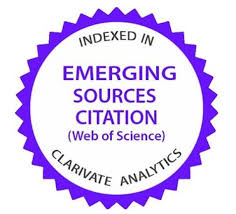Multimodal Competence of Future Teachers – A Context of Understanding and Opportunities for Development in University Education
DOI:
https://doi.org/10.23947/2334-8496-2025-13-2-505-513Keywords:
multimodal competence, operationalization and development opportunities, multimodal technologies, multimodal resources, university teacher educationAbstract
This article explores the formation and development of multimodal competence of preservice teachers in the context of teaching the disciplines Pedagogy of Construction and Technology Activities and Productive Activities in Technical and Technological Education in Kindergarten and in School 1st to 4th year classes. Students’ multimodal competence is seen as a synergistic confluence of knowledge and skills related to different modes of communication - verbal, non-verbal, visual and digital. The focus is on the skills of selecting, combining, adapting and developing multimodal educational content, integration of communication channels and technological combination of different modalities in multimodal modes. The pilot study evaluated the feasibility of designing multimodal resources that respond to students’ ages, levels of competence, learning styles, technological capabilities, and subject matter content, as well as creating learning environments that support students’ cognitive, social, emotional, and personal development. The article emphasizes the need to integrate this knowledge into pedagogical practice, taking into account the ethical principles and value focuses that guide the design of multimodal environment. The results of the study show a significant improvement in students’ skills in creating and adapting multimodal resources, and also highlight the importance of applying new technologies and artificial intelligence in the educational process in order to develop critical thinking, creative expression and personal growth in children and students.
Downloads
References
Bekturova, М., A. Zhaitapova, D. Gaipov, S. Tulepova, G. Dyankova (2024). Digital tools and academic writing: a moderated mediation model of writing self-efficacy. The journal of teaching English for specific and academic purposes, 12(3), 609−618. https://doi.org/10.22190/JTESAP240821047B DOI: https://doi.org/10.22190/JTESAP240821047B
Dašić, D., Ilievska Kostadinović, M., Vlajković, M., & Pavlović, M. (2024). Digital Literacy in the Service of Science and Scientific Knowledge. International Journal of Cognitive Research in Science, Engineering and Education (IJCRSEE), 12(1), 219–227. https://doi.org/10.23947/2334-8496-2024-12-1-219-227 DOI: https://doi.org/10.23947/2334-8496-2024-12-1-219-227
Dermendzhieva, S., N. Tsankov (2023). Designing a multimodal environment for cognitive and creative activity in pre-school education – competence of the teacher. International Journal of Cognitive Research in Science, Engineering and Ed-ucation (IJCRSEE), 11(2), (351-358). https://doi.org/10.23947/2334-8496-2023-11-2-351-358 DOI: https://doi.org/10.23947/2334-8496-2023-11-2-351-358
Dyankova, G. (2019). Slovesnata deistvenost na uchitelya I prosocialnoto povedenie na deteto. [The teacher’s verbal effectiveness and the child’s prosocial behavior]. Veliko Tarnovo: European Information Center.
Georgieva, D. (2021). Development of Communicative Skills in Children with Multiple Disorders through the Method of Facilitated Communication. Pedagogy, 93(2), 201-222. https://doi.org/10.53656/ped2021-2.04 DOI: https://doi.org/10.53656/ped2021-2.04
Makarova, A. E., & L. Makarova, E. (2018). Blending Pedagogy And Digital Technology To Transform Educational Environment. International Journal of Cognitive Research in Science, Engineering and Education (IJCRSEE), 6(2), 57–66. https://doi.org/10.5937/ijcrsee1802057M DOI: https://doi.org/10.5937/ijcrsee1802057M
Mihova, M. (2023). Akcenti v profesionalnata kompetentnost na uchitelya v konteksta na ideyata za versiite (1.0, 2.0, …) [Accents in the professional competence of the teacher in the context of the idea of versions (1.0, 2.0, …)]. Education: classicism and modernity. Veliko Tarnovo: University Press “St. St. Cyril and Methodius”. https://www.univt-vratsa.com/wp-content/uploads/2024/06/VRACA-12_2023.pdf
Norris, S. (2020). Multimodal Interaction Analysis. https://onlinelibrary.wiley.com. https://doi.org/10.1002/9781405198431.wbeal0814.pub2 DOI: https://doi.org/10.1002/9781405198431.wbeal0814.pub2
Novkovic, B., Stošić, L., Belousova, A. (2018). Media and Information Literacy -the Basis for Applying Digital Technologies in Teaching from the Discourse of Educational Needs of Teachers. Croatian Journal of Education. 20(4), 1089-1114 https://doi.org/10.15516/cje.v20i4.3001 DOI: https://doi.org/10.15516/cje.v20i4.3001
O’Halloran, K. (2011). Multimodal Discourse Analysis. In K. Hyland and B. Paltridge (eds.) Companion to Discourse, London: Continuum: 120-137. http://hdl.handle.net/20.500.11937/40301
Scollon, R., & Wong Scollon, S. (2003). Discourses in Place: Language in the Material World. Routledge. https://doi.org/10.4324/9780203422724 DOI: https://doi.org/10.4324/9780203422724
Simonović, N. (2021). Teachers’ Key Competencies for Innovative Teaching. International Journal of Cognitive Research in Science, Engineering and Education (IJCRSEE), 9(3), 331–345. https://doi.org/10.23947/2334-8496-2021-9-3-331-345 DOI: https://doi.org/10.23947/2334-8496-2021-9-3-331-345
Stanišić, T., Leković, M., & Stošić, L. (2019). Relationship between the quality of higher education and Balkan countries’ com- petitiveness. International Journal of Cognitive Research in Science, Engineering and Education (IJCRSEE), 7(3), 49-59. https://doi.org/10.5937/IJCRSEE1903049S DOI: https://doi.org/10.5937/IJCRSEE1903049S
Stosic, L., Dermendzhieva, S., & Tomczyk, L. (2020). Information and communication technologies as a source of education. World Journal on Educational Technology: Current Issues, 12(2), 128-135. https://doi.org/10.18844/wjet.v12i2.4815 DOI: https://doi.org/10.18844/wjet.v12i2.4815
Tasevska, D. (2023). Rolya na videoigrite vyrhu mentalnata rotaciya I kratkosrochnata pamet. [Role of video games on mental rotation and short-term memory]. Diogenes Library – Psychology, 31(1). Veliko Tarnovo: University Publishing House “St. Cyril and Methodius”. https://doi.org/10.54664/BZME3447 DOI: https://doi.org/10.54664/BZME3447
Tasevska, D., Yonkova K., E. Boradzhieva (2015). Praktiki na komunikativnata tehnologiya vyv Visheto ucilishte. [Practices of communicative technology in higher education: traditions and innovation]. Diogenes Library – Psychology, 23(1). Veliko Tarnovo: University Publishing House “St. Cyril and Methodius”.
Tor, D., Başaran, S. D. & Arık, E. (2022). Examining of the Digital Literacy Level of Teacher Candidates. Ahi Evran Üniversitesi Kırşehir Eğitim Fakültesi Dergisi, [online] 23(2), 2027-2064. https://doi.org/10.29299/kefad.1047590
Tsankov, N., S. H. Dermendjieva (2024). Designing Digital Resources for Multimodal Composition in the Kindergarten Environment. International Journal of Cognitive Research in Science, Engineering and Education (IJCRSEE), 12(2), 489-496). https://doi.org/10.23947/2334-8496-2024-12-2-489-496 DOI: https://doi.org/10.23947/2334-8496-2024-12-2-489-496
Vesić, D., Laković, D., & Vesić, S. L. (2023). Use of Information Technologies in Higher Education From The Aspect of Manage- ment. International Journal of Cognitive Research in Science, Engineering and Education (IJCRSEE), 11(1), 143-151. https://doi.org/10.23947/2334-8496-2023-11-1-143-151 DOI: https://doi.org/10.23947/2334-8496-2023-11-1-143-151
Published
How to Cite
Issue
Section
Categories
License
Copyright (c) 2025 Nikolay Tsankov

This work is licensed under a Creative Commons Attribution 4.0 International License.
Plaudit
Accepted 2025-07-04
Published 2025-08-26












